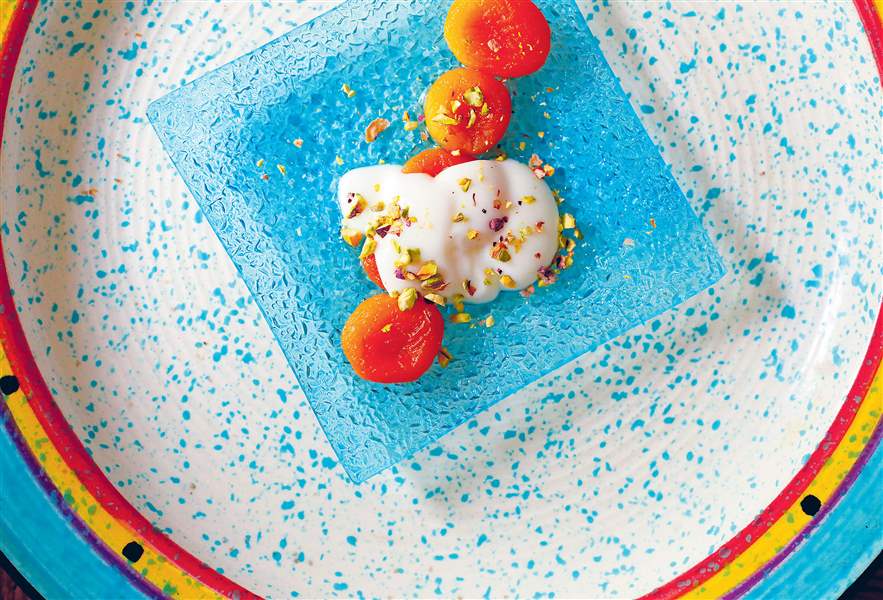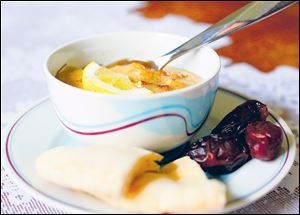
FOOD & NUTRITION
Fast food: Ramadan-friendly recipes for month-long observance
6/24/2014
Apricots with yogurt and pistachios.
THE BLADE
Buy This Image

Apricots with yogurt and pistachios.
Ramadan, Islam‘s holiest month, begins Saturday night at sundown. Each day during Ramadan, from sunrise to sunset, observant Muslims will not take any food or water.
When Catholics fast on Ash Wednesday and on Good Friday, they are permitted one small meal plus snacks that, combined, are not to equal another full meal. When Jews fast on Yom Kippur, the Day of Atonement, they aren‘t allowed to have either food or water for 25 hours.
Muslims will fast each day for the entire month of Ramadan, in accordance with Surah (Chapter) 2:183-185 of the Qur‘an: “O ye who believe! Fasting is prescribed for you, even as it was prescribed for those before you, that ye may ward off (evil) .... The month of Ramadan in which was revealed the Qur’an, a guidance for mankind, and clear proofs of the guidance, and the Criterion (of right and wrong). And whosoever of you is present, let him fast the month ....”
Fasting is a form of self-denial intended to encourage reflection, introspection, patience, and humility. Rich and poor fast, men and women fast. There are no distinctions.
According to Arto der Haroutunian, in North African Cookery:
“Tradition has it that during Ramadan the gates of Heaven are opened, the gates of Hell closed and the Devils chained. It also expresses the belief that whosoever observes the Ramadan Fast will obtain forgiveness of all his sins. Fasting is one of the five ’Pillars of the Faith’ and is regarded by all ... as a must.“
Iftar, the evening meal, is ideally shared with family and with the larger community at group dinners. It is necessarily substantial without being too heavy.
In honor of the prophet Mohammed, who is said to have done this, it is customary for many to first eat three dates when they sit down to break the day’s fast. The meal itself then consists of a wide variety of foods, dependent upon country and culture.

Harira, soup with chick peas, served with pita bread and dates.
Harira - a spiced Moroccan soup that varies regionally, often featuring lamb and tomatoes in addition to legumes - is a traditional Ramadan offering. The recipe below, with chicken and chickpeas, is very nutritious and comforting. The aroma wafting through the kitchen as the onions cook along with the chicken and the cinnamon is exotic and wonderfully enticing.
The Turkish apricots served for dessert with vanilla yogurt and a sprinkling of pistachios appeal to most of the senses: gorgeous to look at, sweet and succulent, fragrant, as well as creamy and crunchy all at once.
Pomegranate molasses is readily found in Middle Eastern markets. Using it in light meringues offers a sweet-tart treat to serve at the end of the evening meal, before bedtime and waking up to another day of fasting.
Contact Mary Bilyeu at mbilyeu@theblade.com or 419-724-6155 or on Twitter @foodfloozie.
RECIPES
- 2 tablespoons extra-virgin olive oil
- 1/2-pound skinless, boneless chicken cut into bite-sized pieces
- 1 15-ounce can chickpeas, rinsed and drained
- 1 medium onion, coarsely chopped
- 8 tablespoons finely chopped parsley
- 1 teaspoon black pepper
- 1/4 teaspoon powdered saffron
- 2 teaspoons salt
- 1 teaspoon cinnamon
- 6 cups chicken stock
- 4 ounces vermicelli or long-grain rice
- 2 tablespoons flour mixed with 1-1/2 cups water until smooth
- thin slice lemon, for garnish
- pita bread, for serving
Harira min Himass (Harira with Chickpeas)
”In North Africa, and particularly in Morocco, the fast is broken with a few spoonfuls of a classic soup called harira. Harira is of Berber origin, hence pre-Islamic. It is a nourishing soup which has many variations .... During the thirty days of Ramadan it is traditionally eaten with dates or honey cakes.“
Heat the oil in a large saucepan (3-quart, at least) over medium-high heat. Add the chicken pieces, drained chickpeas, onion, parsley, pepper, saffron, salt and cinnamon and fry for 2-3 minutes, stirring frequently. Add the stock and bring to a boil. Cover the pan, lower the heat and simmer for 1 hour.
Whisk in the vermicelli and bring to a boil; lower heat and cook on low, stirring constantly to keep the vermicelli from clumping, for 10 minutes. Stir in the flour mixture and bring to a boil, stirring constantly. If the mixture is too thick add a little more water. Remove the soup from the heat and serve in bowls with a slice of lemon on top. Serve with pita bread and dates.
Serves 4-6.
Source: Adapted from North African Cookery by Arto der Haroutunian
Kaymakli Kayisi Tatlisi (Dried Apricots Stuffed with Cream)
- 1 generous cup dried apricots
- 3/4 water + water for soaking
- 1/4 sugar
- spritz of lemon juice
- 2 tablespoons honey
- 1 6-ounce cup vanilla-flavored yogurt
- 1/4 cup finely chopped pistachios
In this dish, the apricots are traditionally stuffed with kaymak, a ”thick, calorific and scrumptious“ cheese-like substance made by reducing buffalo milk. This adaptation utilizes yogurt for ”an easy and luxurious“ dessert.
Place the apricots in a small saucepan and cover with water to 1” over the fruit. Bring to a boil then remove from heat; let rest 1 hour. Drain apricots and discard water.
Place the 3/4 cup water, the sugar, and the lemon juice into the saucepan; bring to a boil, then turn heat to medium. Add honey and swirl to mix. Carefully place apricots into syrup and cook for 20 minutes, stirring occasionally. Let cool to room temperature.
To serve: divide the apricots among 4 serving dishes. Top with a dollop of the yogurt. Sprinkle with pistachios.
Serves 4.
Source: Adapted from Turkish Cooking by Gulseren Sancakli and Margaret Oliphant
Pomegranate Meringues
- 2/3 cup + 1 tablespoon sugar
- 1/8 cup water
- 1/8 cup pomegranate juice
- 2 tablespoons pomegranate molasses
- pinch of salt
- 1/4 teaspoon red food coloring
- 2 large egg whites
- decorative sprinkles or colored sugars (optional)
Preheat the oven to 250F Line a baking sheet with parchment paper.
In a small saucepan, heat sugar, water, juice, pomegranate molasses, and salt just until sugar is dissolved.
In a large mixing bowl using an electric mixer, beat the egg whites on high speed until soft peaks form; add the 1 tablespoon sugar and beat for 1 more minute. Very slowly, pour in the pomegranate mixture while mixing on high speed; beat until soft peaks form again and the mixture is very glossy and pink.
Place the meringue into a pastry bag (use a decorative tip, if you’d like). Pipe meringues 2“ apart onto the prepared baking sheet. Top with decorations, if using.
Place the baking sheet into the oven and let meringues dry for 1-1/2 hours; they will feel a bit rubbery when very lightly touched. Leave meringues in the oven for another 2 hours or more to fully dry the centers. When ready, they will be set rather than soft, and easily peel off the parchment paper.
Makes 32 meringues.
Source: Mary Bilyeu